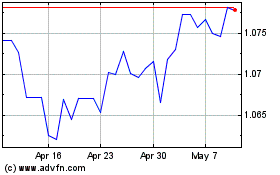Euro Slides As German PMI Hits 16-Month Low
November 20 2014 - 4:50AM
RTTF2
The euro weakened against the other major currencies in the
European session on Thursday after data showed that Germany's
private sector activity expanded at the slowest pace since July
last year.
Data from Markit Economics showed that the composite output
index fell to 52.1 in November from 53.9 in October. The activity
expanded for 19 consecutive months but it was the slowest expansion
in 16 months.
Output growth slowed at both manufacturers and service
providers. The services Purchasing Managers' Index dropped
unexpectedly to 52.1 from 54.4 a month ago. The score was forecast
to rise to 54.5.
Likewise, the PMI for manufacturing fell to 50 from 51.4 in
October, while it was expected to improve to 51.5.
The currency showed little reaction to the Eurozone PMI
data.
Data from the same agency showed that Eurozone private sector
growth slowed unexpectedly to a 16-month low in November. The
composite output index dropped to 51.4 in November, the lowest
score since July of last year, from 52.1 in October. Economists had
forecast it to rise to 52.3.
The flash services Purchasing Managers' Index slid to 51.3 from
52.3 a month ago. The score was forecast to rise to 52.4.
Meanwhile, the European stocks are also lower, as minutes of the
U.S. Federal Reserve's most recent policy meeting offered little
insight into when interest rates could rise. The U.K.'s FTSE 100
index is currently down 0.37 percent or 24.87 points at 6,671,
France's CAC 40 index is down 0.75 percent or 31.97 points at 4,234
and Germany's DAX is down 0.54 percent or 51.55 points at 9,421. In
the Asian trading, the Euro held steady against most major
currencies.
In the European trading, the Euro fell to a 2-day low of 1.2503
against the U.S. dollar, from an early high of 1.2574. If the euro
extends downtrend, it is likely to find support around the 1.23
area.
Pulling away from a multi-year high of 149.13 against the yen,
the euro edged down to 148.31. On the downside, 146.00 is seen as
the support level for the euro.
Against the pound, the euro edged down to 0.7993 from an early
high of 0.8026. The euro is likely to find support around the 0.793
area.
The euro edged down to 0.2010 against the Swiss franc around
4:00 am ET. The euro may test support near the 0.19 region.
Pulling away from multi-day highs of 1.6040 against the NZ
dollar and 1.4265 against the Canadian dollar, the euro fell to
1.5943 and 1.4194, respectively. The euro is likely to find support
around 1.57 against the kiwi and 1.40 against the loonie.
Against the Australian dollar, the euro dropped to 1.4549 from a
multi-week high of 1.4631. If the euro extends its downtrend, it is
likely to find support around the 1.43 area.
Looking ahead, U.S. weekly jobless claims for the week ended
November 15, U.S. manufacturing PMI for November, leading indicator
and existing home sales data for October, flash Eurozone consumer
sentiment index for November and Canadian wholesale sales data for
September are due to be released in the New York session.
At 7:45 am ET, Federal Reserve Governor Daniel Tarullo will
deliver a speech at the Clearing House Conference in New York.
Euro vs US Dollar (FX:EURUSD)
Forex Chart
From Mar 2024 to Apr 2024

Euro vs US Dollar (FX:EURUSD)
Forex Chart
From Apr 2023 to Apr 2024
